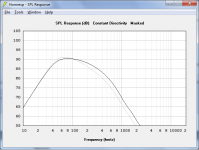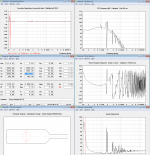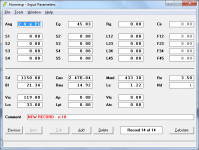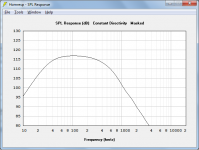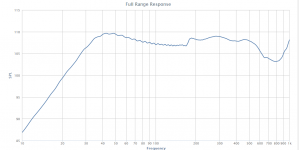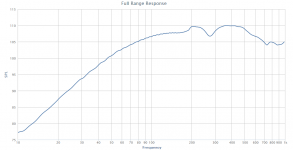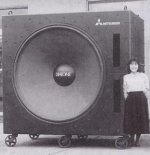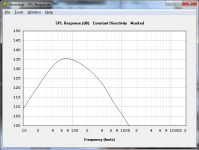Not even close. If you believe the manufacturer's claims the Jackhammer (with 24 inch square cone - 3116 sq cm) does 35 mm linear one way excursion. That's WAY more than this thing - almost 1/3 more for those who don't care to do the math. And the Jackhammer will take 4000 wrms (again, according the manufacturer's claims), well over 3x the SI 24 rated limit. The Jackhammer is a lot more $$$ but that's not the point, the point here is that the new SI driver isn't breaking any records and isn't really that special, no matter what spectacular (but incorrect) marketing claims Stereo Integrity wants to make on their website.
JackHammer 24" Dual 2Ω 4000W RMS SuperWoofer
Are the jackhammers linear excursion claims verified with Klippel data? If so, I would like to see the data. Or at least THD figures in a specified enclosure with clamped power to authenticate their claims.
And like the Jackhammer, just because you can doesn't mean you should. All the SI drivers have very small voice coils and very small power ratings. This 24 inch driver has only a 3 inch voice coil. This is bad news in terms of probable power compression and possible thermal failure. And 5.3 mh inductance is kind of high. In fact it's so high I'm surprised they even mentioned it, most manufacturers would prefer to hide info like that.
You are correct, most companies would hide it. Those figures were taken from the first prototype woofer. Improvements have been made. Inductance is nothing to hide from no matter what the figure may be.
Anyway, the 18 inch SI HT was a decent bargain at the preorder price (it's only an average value at it's current price) even though it suffers from a lot of the same problems I just mentioned, this new one is not quite as impressive.
The SI HT 18" beats its nearest competitor (the Dayton 18) by over 2 dB...and the SI is less expensive. How is that an "average value"?
If I was looking for a high excursion IB driver I'd much prefer the RE XXX. It's got about 85 percent of the SI 24's displacement potential and it's only a bit more expensive but it's a MUCH better driver. (Actually the XXX has free shipping in the US and the SI 24 doesn't so it's probably the same price overall for US customers.)
RE Audio XXX18D2 (XXX18-D2) 18" Dual 2 ohm Car Subwoofer
No I'm not. This is the claim directly from the SI website.
That's also the claim in the first sentence of this thread. Both of these claims are wrong.
Furthermore the Jackhammer would work just fine IB. It might need a bit of eq but there's no reason it couldn't be used in that configuration.
They probably did. Would still applaud the effort they put into it, it's not a huge company, they probably spent a lot of time on this. Too bad the focus is purely on xmax and power handling.
If power handling and Xmax were the main design goals why is it "only" rated at 1500 watts RMS? Wouldn't it be rated at 4,000 watts RMS and have over 60mm Xmax? Odd, seeing as how it is rated at a realistic 1500 watts RMS and 32mm Xmax. Far from a "focus purely on Xmax and power handling" as you stated.
Are the jackhammers linear excursion claims verified with Klippel data? If so, I would like to see the data. Or at least THD figures in a specified enclosure with clamped power to authenticate their claims.
I have no idea what the Jackhammer specs are based on. But the Jackhammer boasts a full 1/3 more excursion than your driver which is no small amount. Even if it's exaggerated a bit it's likely got at least a bit more clean displacement than the SI 24. You can pretend the Jackhammer doesn't exist or that MTX are a bunch of liars if you want but if you want to claim your driver has the most displacement of any driver in the world, I think it's up to you to prove your claims, not MTX.
But you bring up a good point. It's good to see Klippel results. Where are yours? I'd like to see the graphs.
You are correct, most companies would hide it. Those figures were taken from the first prototype woofer. Improvements have been made. Inductance is nothing to hide from no matter what the figure may be.
In that case you should remeasure and update the parameters on your website. If Le is different as a result of physical changes the other specs have also changed. People are going to be using your published specs to make enclosures, you should have the most up to date specs published.
This brings up another interesting point though. The SI HT 18 prototype as measured by data-bass.com lists a lower Le than the production model specs on your website. (Prototype 1.22 mH, production model 3.2 mH.) So I'll reserve judgement on the improvements that have been made on the SI 24 until I see the Klippel graphs or measurements from data-bass.com (or similar reputable reviewer).
The SI HT 18" beats its nearest competitor (the Dayton 18) by over 2 dB...and the SI is less expensive. How is that an "average value"?
Price - SI 18 - $190 + shipping
- Dayton - $250 w/ shipping included
Depending on how much shipping costs the SI might be a bit less expensive but probably not much. But if you buy in quantities of 4 or more, or if you buy when the Dayton is on sale, the SI is actually probably MORE expensive.
Sensitivity - published specs - SI 18 - 88.7 db 1w/1m
- Dayton - 89.2 db 1w/1m
- as measured by data-bass.com - SI 18 - 88.62
- Dayton - 88.68
Not sure how you figure it beats the Dayton by 2 db since the specs (as published and as measured by data-bass.com) say the Dayton is actually louder.
Average value - Price (with shipping) and sensitivity are very close. Clean displacement (as determined by data-bass.com and regardless of the published specs) is very close.
The Dayton has a larger voice coil and 1/3 more rated power handling. The Dayton has 1/3 less inductance (according to published specs).
I was quite vocal about the SI HT 18 being the value/displacement leader at the preorder price. You can check my older posts if you want. But at the current price it's only an average value and to be honest I'm not impressed by the price or specs of the SI 24 at all compared to other drivers on the market.
Last edited:
If power handling and Xmax were the main design goals why is it "only" rated at 1500 watts RMS? Wouldn't it be rated at 4,000 watts RMS and have over 60mm Xmax? Odd, seeing as how it is rated at a realistic 1500 watts RMS and 32mm Xmax. Far from a "focus purely on Xmax and power handling" as you stated.
32 mm? Your website says 36 mm. Which is it?
If it's only 32, the RE XXX 18 has only 4 percent less rated displacement than the SI 24.
The connection is made only by you.
I said less wattage for the sealed version for max excursion (Xmax) obviously.
Any more questions you don't understand?
?? Excuuuse me, master!
Yeah, maybe master of stupidity... for being here in this crazy forums?! Just having fun.?? Excuuuse me, master!
Dayton Audio RSS460HO-4 18" vs. SI 18 HT

The SI HT 18" beats its nearest competitor (the Dayton 18) by over 2 dB...and the SI is less expensive. How is that an "average value"?
I would stay with the first statement (1 or 2 dB's average for a smaller vented enclosure also) for frequencies lower than 50Hz.Sensitivity - published specs - SI 18 - 88.7 db 1w/1m
- Dayton - 89.2 db 1w/1m
- as measured by data-bass.com - SI 18 - 88.62
- Dayton - 88.68
Not sure how you figure it beats the Dayton by 2 db since the specs (as published and as measured by data-bass.com) say the Dayton is actually louder.

I'm going to stick with my statement. Attached is a pic of both drivers simulated in 3 cubic feet with published specs with 1w input. Which is which? The one with the flatter top end is the one with less inductance. The SI has a vague advantage between ~30 - 90 hz but since the Dayton has 1/3 more power handling it ultimately wins when push comes to shove.
Where is this 2 db advantage you guys are talking about?
Where is this 2 db advantage you guys are talking about?
Attachments
If power handling and Xmax were the main design goals why is it "only" rated at 1500 watts RMS? Wouldn't it be rated at 4,000 watts RMS and have over 60mm Xmax? Odd, seeing as how it is rated at a realistic 1500 watts RMS and 32mm Xmax. Far from a "focus purely on Xmax and power handling" as you stated.
We have a difference of opinion then. My opinion is: 1500W is a lot of energy, most of it will be converted to heat, not sound.
Would rather have a more efficient woofer with higher resistance to make an easier load at low frequencies. But that would also demand more enclosure volume. All a compromise I guess.
That said, at 2,83V your 18 HT simulates silly good here. Makes me actually believe your specs are indeed 1w/1m. This is at ~600L. I think 112dB within xmax, simulated at 13Hz with 40V is very good in halfspace (2/pi). The goal was predictable phase. Can anyone do better? Out of time.
Attachments
I have no idea what the Jackhammer specs are based on. But the Jackhammer boasts a full 1/3 more excursion than your driver which is no small amount. Even if it's exaggerated a bit it's likely got at least a bit more clean displacement than the SI 24. You can pretend the Jackhammer doesn't exist or that MTX are a bunch of liars if you want but if you want to claim your driver has the most displacement of any driver in the world, I think it's up to you to prove your claims, not MTX.
But you bring up a good point. It's good to see Klippel results. Where are yours? I'd like to see the graphs.
MTX claims 34 mm. How is that 1/3 more than ours at 35 mm? Our first motor iteration was Klippel'd at 31 mm and with the improved topology and longer coil that we are using on the 24 it will have 35mm or more one-way liner travel. We will be sending out the motor on a smaller 15" driver to be Klippel tested this week. It's hard to find someone who can Klippel test a 24.
Here is the Klippel graph from the first motor that we did not even put in to the prototype phase:
An externally hosted image should be here but it was not working when we last tested it.
In that case you should remeasure and update the parameters on your website. If Le is different as a result of physical changes the other specs have also changed. People are going to be using your published specs to make enclosures, you should have the most up to date specs published.
This brings up another interesting point though. The SI HT 18 prototype as measured by data-bass.com lists a lower Le than the production model specs on your website. (Prototype 1.22 mH, production model 3.2 mH.) So I'll reserve judgement on the improvements that have been made on the SI 24 until I see the Klippel graphs or measurements from data-bass.com (or similar reputable reviewer).
Josh's measurements may have been performed at a higher frequency, which will make Le look lower. Even if Le measures lower it is nothing to complain about. That's like complaining that your 100 watt amplifier actually puts out 200 watts.
Price - SI 18 - $190 + shipping
- Dayton - $250 w/ shipping included
Depending on how much shipping costs the SI might be a bit less expensive but probably not much. But if you buy in quantities of 4 or more, or if you buy when the Dayton is on sale, the SI is actually probably MORE expensive.
Sensitivity - published specs - SI 18 - 88.7 db 1w/1m
- Dayton - 89.2 db 1w/1m
- as measured by data-bass.com - SI 18 - 88.62
- Dayton - 88.68
Not sure how you figure it beats the Dayton by 2 db since the specs (as published and as measured by data-bass.com) say the Dayton is actually louder.
From Josh Ricci's site. The Dayton is down by ~2 dB at 20 Hz and 25 Hz and the SI is louder over the entire bandwidth that he tested each driver with.
An externally hosted image should be here but it was not working when we last tested it.
You don't always want a more sensitive driver if you want bass below 50 Hz. Here is a graph using two radically different sensitivity drivers showing output between the two in the same size sealed box. Spoiler alert, the louder one below 50 Hz is the least sensitive:
An externally hosted image should be here but it was not working when we last tested it.
Higher sensitivity drivers usually have shorter coils, less cone travel, lighter materials, etc. Those are all good if you are after output above 50 Hz. But when stroke is needed to produce output down low (especially in an IB woofer) you need lots of cone travel. Compare any dedicated 18" PA woofer with a sensitivity higher than say 99 dB to our HT 18" woofer and see which one has more output below 50 Hz without destroying itself. Here is a quick model of our HT 18 compared to an Emminence 18 in an IB alignment. The lower sensitivity driver not only plays much lower but also louder.
An externally hosted image should be here but it was not working when we last tested it.
You are correct about the displacement king. The Jackhammer holds that crown. We had honestly forgotten about that woofer and our web text on our IB 24" has been edited to reflect that. Looks like if you want to out-displace our IB 24" you will need $9,999 and a slew of amplifiers to drive it to Xmax. The suspension on those Jackhammers are like concrete.
Looks like if you want to out-displace our IB 24" you will need $9,999....
good point
now, please consider making a hifi woofer with lower cone weight and less focus on 'out-displacing-contest'
We have a difference of opinion then.
Yeah, I agree. It's obviously important to SI to claim the highest displacement driver on the market, so if he could have made it 4000 wrms with 60 mm xmax at a reasonable price he would have.
That said, at 2,83V your 18 HT simulates silly good here. Makes me actually believe your specs are indeed 1w/1m. This is at ~600L. I think 112dB within xmax, simulated at 13Hz with 40V is very good in halfspace (2/pi). The goal was predictable phase. Can anyone do better? Out of time.
As far as a pure simulation goes it doesn't look bad but in real life it would be terrible with a boomy bottom end and no top end. Here's another simulation to compare attached below.
Pic 1 - you can see I used the parameters as measured by data-bass.com (prototype) in a 4.2 cubic foot sealed box, since that's the size and alignment he used to measure.
Pic 2 - simulated response.
Pic 3 - measured response.
Pic 4 - measure response of a pro driver (b&c 21) for comparison.
As you can see the simulated response looks nothing like the measured response. That's what happens when large xmax values are a primary goal. There's nothing wrong with that but you have to know what you are getting into and that simulations don't tell the whole story.
Check all the drivers at data-bass.com. ALL the large displacement drivers have a measured rolled off top end that does not agree with simulations. ALL the pro drivers have a nice full top end that reflects the simulations fairly accurately.
The SI HT 18 isn't as bad as some of the other high displacement drivers, some are substantially worse. But remember, data-bass.com measured the prototype SI HT 18 with only 1.22 mH inductance, the production model has 3.2 mH so the results with a production driver would probably look much worse.
Attachments
MTX claims 34 mm. How is that 1/3 more than ours at 35 mm?
Sure, I'll do the math for you. Displacement = xmax x Sd.
Jackhammer - 3122 cm Sd x 3.43 cm xmax = 10708.5 cc
SI 24 - 2129.4 cm Sd x 3.6 cm xmax = 7665.8 cc (published xmax)
SI 24 - 2129.4 cm Sd x 3.2 cm xmax = 6814.1 cc (xmax as per post 21)
7665.8 / 10708.5 = 71.6 percent
6814.1 / 10708.5 = 63.6 percent
So depending on which value of xmax is correct for your driver, it has just under or just over 1/3 less rated displacement than the Jackhammer. Remember, the MTX is a 24 inch square cone so it has a lot more Sd than yours.
Our first motor iteration was Klippel'd at 31 mm and with the improved topology and longer coil that we are using on the 24 it will have 35mm or more one-way liner travel. We will be sending out the motor on a smaller 15" driver to be Klippel tested this week. It's hard to find someone who can Klippel test a 24.
Here is the Klippel graph from the first motor that we did not even put in to the prototype phase:
That's nice but where are the other graphs?
Displacement limit due to compliance variation?
Displacement limit due to inductance?
Displacement limit due to IM distortion?
Etc.
Please don't show me a single graph from a pre prototype and expect me to believe that your production model which hasn't been measured yet is going to measure exactly the way you think it will.
From Josh Ricci's site. The Dayton is down by ~2 dB at 20 Hz and 25 Hz and the SI is louder over the entire bandwidth that he tested each driver with.
He tested your driver at 95 volts, or approximately 2500 wrms. That's more than 4x it's rated power handling. Are you going to honor the warranty if your customers try to get this level of performance out of your driver? If not then you probably shouldn't advertise the CEA spec as measured by data-bass.com.
An avs member fried a couple of your drivers with a pair of 1000 watt amps IIRC. In that light, my ratings are based on published power handling, not edge of destruction torture testing.
You are correct about the displacement king. The Jackhammer holds that crown. We had honestly forgotten about that woofer and our web text on our IB 24" has been edited to reflect that. Looks like if you want to out-displace our IB 24" you will need $9,999 and a slew of amplifiers to drive it to Xmax. The suspension on those Jackhammers are like concrete.
I see you added a note at the bottom of the description but the page still says:
With 36mm of Xmax and a surface area of 212943.8mm^2 it is largest displacement subwoofer on the planet.
That statement is still as wrong as it was yesterday. And what does price have to do with anything? It's either the highest displacement driver on the planet or it's not.
Last edited:
good point
now, please consider making a hifi woofer with lower cone weight and less focus on 'out-displacing-contest'
There are dozens of companies that already fit that niche, especially those that make pro gear. There's a genuine need and market for this kind of driver. It's not my thing and I don't care for the SI 24 at all but it is nice to see these products (especially at preorder prices).
I wonder how much Xmax it needs
Based on a usable 6 foot diameter it would need .3mm to beat the SI 24 and .41mm to beat the Jackhammer.
Originally Posted by Electrodynamic
Looks like if you want to out-displace our IB 24" you will need $9,999 and a slew of amplifiers to drive it to Xmax. The suspension on those Jackhammers are like concrete.
Out of curiosity I did a quick sim. In the manufacturer recommended sealed box the Jackhammer takes about 15000 wrms to hit xmax. You get response as pictured below.
Or you can go IB (5200 liters) and get by with less than 2000 watts. So you don't need a slew of amps, but you do need one that's 1 ohm stable into a single channel (or one that's 2 ohm stable into 2 channels).
It's no secret that the Jackhammer is a flaming pile of seriously overpriced crap but it is the displacement king of moving coil drivers. (AFAIK. There could be some monstrosity like the one pictured above with even more displacement.)
Attachments
It's no secret that the Jackhammer is a flaming pile of seriously overpriced crap ....
oh ...
so we are now left with ... nothing

Like I said in post #4:
There are plenty of good high displacement drivers though, the RE XXX that I've mentioned a few times is one of them. There's more from Ascendant Audio, Fi, Mach5Audio and a few other places too. Data-bass.com has reviewed a nice selection.
It's usually better to use multiple smaller drivers than a single huge driver though, and that really opens up the options.
The Jackhammer is a well known fail only good for ego feeding. Nobody that knows anything about audio would buy one. But it is the displacement king (afaik), even if that is only a novelty specification on paper that has nothing to do with realistic real world performance. You can't claim you have the highest displacement driver on the planet unless you can prove you can beat the Jackhammer (even if it is a flaming pile of crap).Just because you can doesn't mean you should.
There are plenty of good high displacement drivers though, the RE XXX that I've mentioned a few times is one of them. There's more from Ascendant Audio, Fi, Mach5Audio and a few other places too. Data-bass.com has reviewed a nice selection.
It's usually better to use multiple smaller drivers than a single huge driver though, and that really opens up the options.
Last edited:
Calm thyself and enjoy this:Like I said in post #4:
The Jackhammer is a well known fail only good for ego feeding. Nobody that knows anything about audio would buy one. But it is the displacement king (afaik), even if that is only a novelty specification on paper that has nothing to do with realistic real world performance. You can't claim you have the highest displacement driver on the planet unless you can prove you can beat the Jackhammer (even if it is a flaming pile of crap).
There are plenty of good high displacement drivers though, the RE XXX that I've mentioned a few times is one of them. There's more from Ascendant Audio, Fi, Mach5Audio and a few other places too. Data-bass.com has reviewed a nice selection.
It's usually better to use multiple smaller drivers than a single huge driver though, and that really opens up the options.
12vdb.com - car audio database: Adire Audio Parthenon.1 - YouTube
Check all the drivers at data-bass.com. ALL the large displacement drivers have a measured rolled off top end that does not agree with simulations. ALL the pro drivers have a nice full top end that reflects the simulations fairly accurately.
The SI HT 18 isn't as bad as some of the other high displacement drivers, some are substantially worse. But remember, data-bass.com measured the prototype SI HT 18 with only 1.22 mH inductance, the production model has 3.2 mH so the results with a production driver would probably look much worse.
Yes, there are several reasons why many of us want higher sensitivity drivers. Was just trying to look at this from another perspective. Although I am not so certain that the 18 HT simulation I did would be so boomy. The phase is very predictable for a driver of this type, and it would be probably difficult to beat it at 13Hz at the price of driver and volume of box. This is after all a subwoofer we're talking about, recommended xo would probably be around 80Hz to avoid various artifacts.
Would love to see a lighter, 1/2 xmax, D4, D8 or maybe "S8" version, "S16" is probably an unrealistic wish.
- Status
- This old topic is closed. If you want to reopen this topic, contact a moderator using the "Report Post" button.
- Home
- Loudspeakers
- Subwoofers
- Stereo Integrity 24" IB Subwoofer- new displacement king of subwoofers
